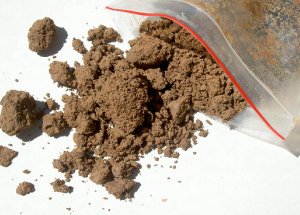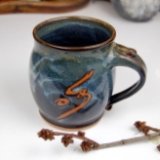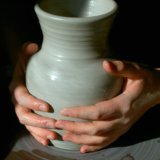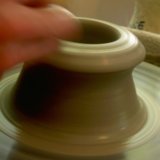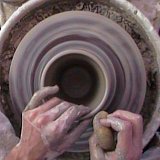|
How to Make ClayLearn how to make clay for your clay pot projects. Learn to choose the right
pottery clay
or mix custom clay recipes. Prepare clay from the ground or purchased from a
ceramic art supplies store.
Local clay sample dug from the ground.
Why Would You Want to Make Your Own Clay? Pro's: 1) It saves money. Con: 1) It's a lot of work. Have A Great Story About Making Homemade Clay?Have you tried your hand at digging or making homemade clay? Give us the "dirt." How did the clay turn out? Share your experience, tips, challenges and photos! What Other Visitors Have SaidClick below to see contributions from other visitors to this page...
Choosing the right Natural clay
When digging clay, why dry it out first and then wet it again?
Why won't the red clay I dug up separate after screeninig?
What is the effect of using different crushed rock when making clay?
Did I Make Clay? Not rated yet
Homemade Ganesha Idol Not rated yet
Mixing Powdered ClayThe first way to make your own pottery clay is to learn how to make homemade clay from a powdered recipe. Premixed powdered clay is cheaper to buy and ship than premixed wet clay. These can be found wherever you find ceramics supplies. Most pottery supply stores have several clay recipes to choose from. Making Clay From a RecipeYou can also learn how to make clay using a custom recipe for homemade clay. Recipes for homemade clay can be found in ceramic magazines, books and on the internet. Most clay recipes include 3-6 raw ingredients. Some common ingredients include: ball clay, talc, kaolin, fire clay, stoneware clay, silica and flint.
Digging Your Own ClayIf you're an adventurous soul, you may want to try digging your own pottery clay. Before ceramic pottery supplies could be purchased at the store, potters dug their own clay from the earth. Clay is commonly found near lakes, river banks, and in clay deposits. Some areas even have established clay pits, where clay is regularly sourced. The experience of digging the clay, processing it, and testing it's properties can be very rewarding. You gain a deeper understanding of your clay by connecting to it's source. If nothing else it gives you a greater appreciation for the ready availability of prepared clay to modern day pottery artists. Testing ClayWhen learning how to make clay, learning how to test the clay body is important. There are four main tests I like to perform on each clay body in order to really get to know it. They are: Workability, Shrinkage, Firing Temperature, and Absorption. Workability- Otherwise known as plasticity or throwability. How far can the clay stretch before cracking? Shrinkage- How much will the clay shrink when dried and fired? This ranges from 5-20%. Most wheel thrown pottery ranges from 8-15%. Firing Temperature- At what firing cone does the clay mature? Cone 022-10.
Absorption- How quickly will the clay absorb moisture after it is fired to maturity. This ranges from about 2-12% for most
electric pottery wheel
pottery.
SafetyWhen learning how to make clay here are a few safety considerations. 1) Always follow the manufacturers recommendations when operating a clay mixer or a pug mill. 2) Avoid breathing clay dust. Wear an approved mask when working with powdered clay and clean up spilled powder with water. 3) When digging clay avoid polluted sources and test the clay for lead if creating functional pottery that will be used with food. There truly are abundant resources for clay. Whether you are digging, mixing, or throwing clay straight out of the bag, Happy Potting.
Learn About Choosing the Right Pottery Clay
|
Learn Right
The First Time
Pottery on the Wheel for Beginners
is a complete beginners guide
to learning pottery.
It will
take you from
never having touched clay
to creating finished pottery
you can use every day.
Also read it on Kindle
Featured Pages
Choose Your Wheel
Thank you so much for
visiting my website!
Discover How I Made It!
Happy Potting!
- Steve





